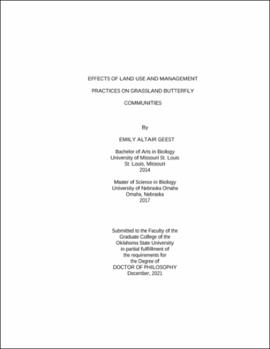| dc.contributor.advisor | Baum, Kristen A. | |
| dc.contributor.author | Geest, Emily Altair | |
| dc.date.accessioned | 2022-05-13T15:26:20Z | |
| dc.date.available | 2022-05-13T15:26:20Z | |
| dc.date.issued | 2021-12 | |
| dc.identifier.uri | https://hdl.handle.net/11244/335714 | |
| dc.description.abstract | Grassland butterflies are undergoing worldwide population declines due to habitat loss and degradation. Rangelands in the southern Great Plains; can provide habitat for grassland butterflies depending on management practices. As grasslands decline, grassland-dependent species, such as grassland butterflies, undergo widespread population losses. To manage remaining grasslands, patch-burn grazing, prescribed fire, and mowing/haying are commonly implemented management practices across the southern Great Plains. However, the impact of management on the butterfly communities is complex, and the effects of different management regimes on butterfly communities are not clear. I investigated the impact of time since prescribed fire and season of fire on butterfly communities in cattle-grazed rangelands in north-central Oklahoma. Species richness varied by time since fire and season of fire, with older spring-burned sites having the highest species richness. Diversity indices and evenness varied by treatment, with older spring-burned sites having the lowest evenness and inverse Simpson's Diversity while recently spring-burned sites had the lowest Shannon-Wiener Diversity of all treatments. Patch-burn grazing creates a mosaic of successional vegetation stages which can benefit different butterfly species and support the overall community. To untangle the effects of variable management regimens and habitat characteristics on butterfly community composition and butterfly community traits, I conducted butterfly and flowering forb surveys at sites across north-central Oklahoma. A total of 942 butterflies were recorded across 39 species over two years, with community measures differing by site. Neither land use intensity nor habitat characteristics had measurable effects on overall butterfly community composition or butterfly community traits. This research adds to the growing body of literature on butterfly community ecology and highlights the need for further studies to understand what factors drive butterfly community patterns. Finally, I created ecological niche models for five Speyeria species of conservation interest by combining each species' known occurrences with climate and environmental variables to identify important response variables and determine the potential distribution of suitable habitat for each species. Response variables differed among species, which highlights each species' different climate and habitat needs. This demonstrates the value of citizen science and photo sharing websites for providing important data for evaluating species distributions. | |
| dc.format | application/pdf | |
| dc.language | en_US | |
| dc.rights | Copyright is held by the author who has granted the Oklahoma State University Library the non-exclusive right to share this material in its institutional repository. Contact Digital Library Services at lib-dls@okstate.edu or 405-744-9161 for the permission policy on the use, reproduction or distribution of this material. | |
| dc.title | Effects of land use and management practices on grassland butterfly communities | |
| dc.contributor.committeeMember | Moranz, Ray A. | |
| dc.contributor.committeeMember | Fuhlendorf, Sam D. | |
| dc.contributor.committeeMember | Rebek, Eric J. | |
| osu.filename | Geest_okstate_0664D_17399.pdf | |
| osu.accesstype | Open Access | |
| dc.type.genre | Dissertation | |
| dc.type.material | Text | |
| dc.subject.keywords | fire ecology | |
| dc.subject.keywords | grassland butterflies | |
| dc.subject.keywords | grassland management | |
| dc.subject.keywords | speyeria | |
| thesis.degree.discipline | Integrative Biology | |
| thesis.degree.grantor | Oklahoma State University | |
